LSBM103 Business Environment Essay: Value Chain Analysis of Sainsbury
VerifiedAdded on 2023/01/16
|9
|2526
|60
Essay
AI Summary
This essay provides a comprehensive value chain analysis of J Sainsbury Plc, a major UK supermarket chain. It begins with an introduction to value chain analysis, outlining its purpose in identifying primary and support activities that contribute to a company's competitive advantage. The essay then applies the value chain model to Sainsbury, examining its inbound logistics, operations, outbound logistics, marketing and sales, and support activities such as infrastructure, human resource management, and technology. The analysis delves into Sainsbury's internal environment, exploring how these activities contribute to its overall business strategy and market position. The essay concludes with a reflection on the value chain model's effectiveness and its implications for Sainsbury's future growth and success in the competitive retail market. The analysis is supported by relevant literature and company data.
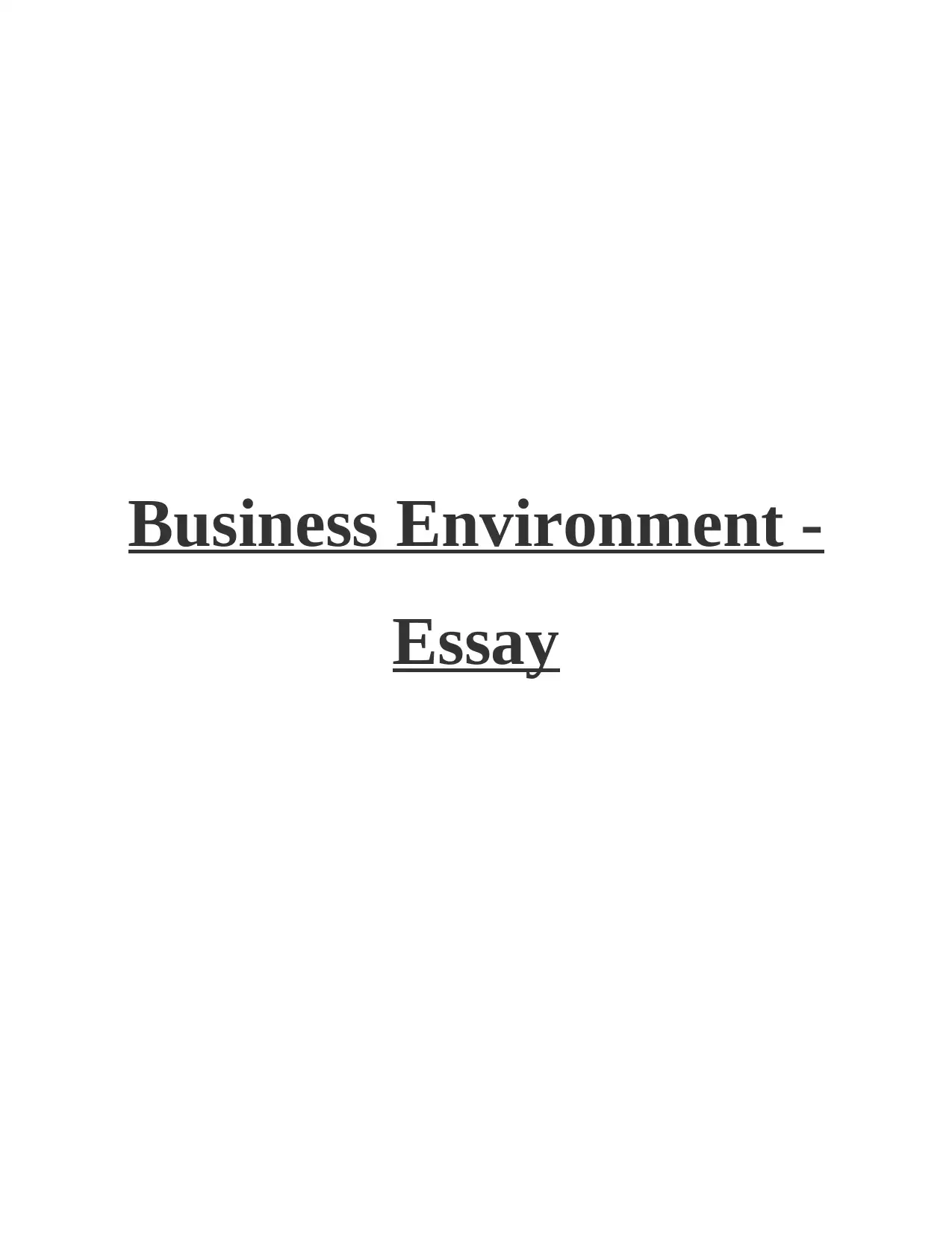
Business Environment -
Essay
Essay
Paraphrase This Document
Need a fresh take? Get an instant paraphrase of this document with our AI Paraphraser
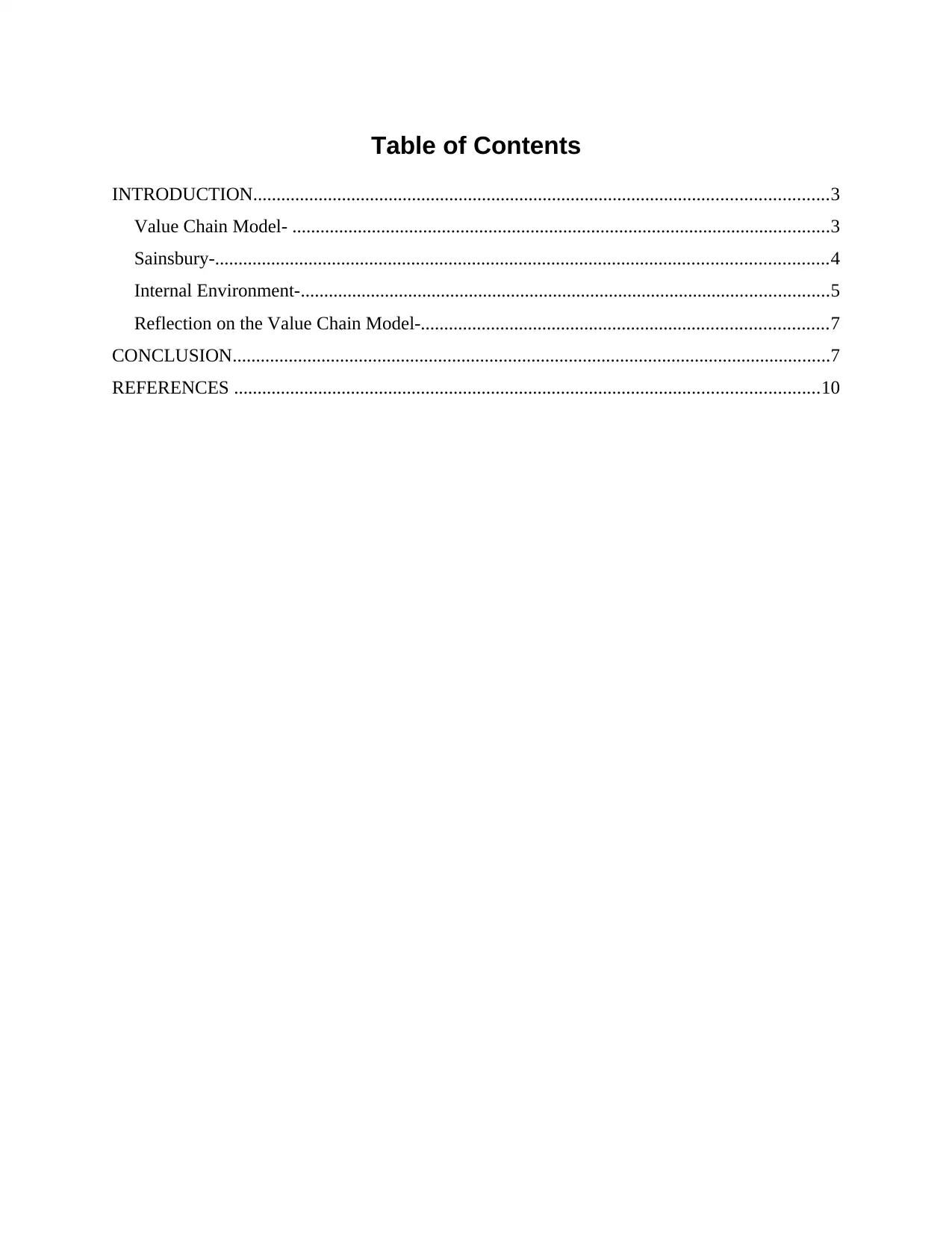
Table of Contents
INTRODUCTION...........................................................................................................................3
Value Chain Model- ...................................................................................................................3
Sainsbury-...................................................................................................................................4
Internal Environment-.................................................................................................................5
Reflection on the Value Chain Model-.......................................................................................7
CONCLUSION................................................................................................................................7
REFERENCES .............................................................................................................................10
INTRODUCTION...........................................................................................................................3
Value Chain Model- ...................................................................................................................3
Sainsbury-...................................................................................................................................4
Internal Environment-.................................................................................................................5
Reflection on the Value Chain Model-.......................................................................................7
CONCLUSION................................................................................................................................7
REFERENCES .............................................................................................................................10
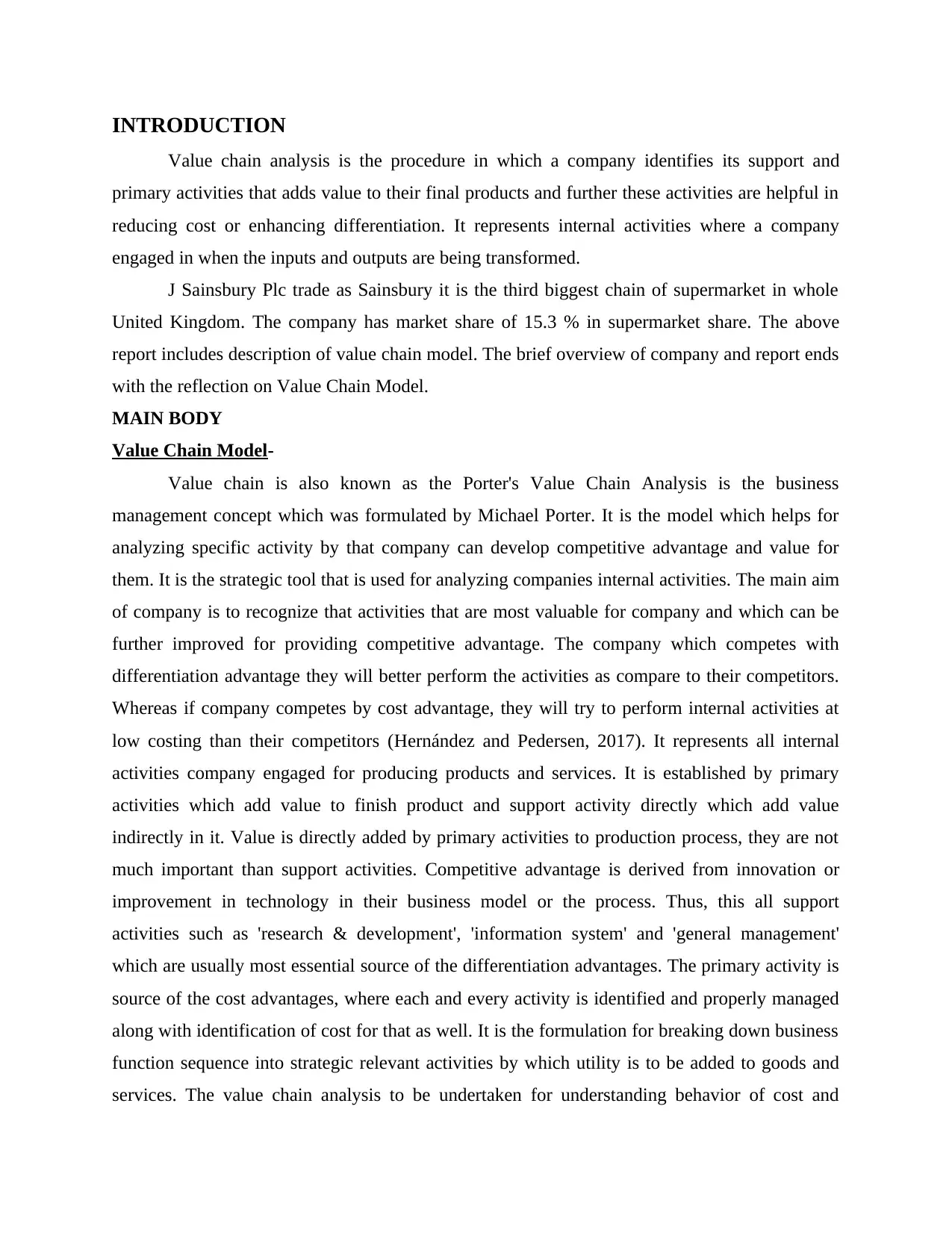
INTRODUCTION
Value chain analysis is the procedure in which a company identifies its support and
primary activities that adds value to their final products and further these activities are helpful in
reducing cost or enhancing differentiation. It represents internal activities where a company
engaged in when the inputs and outputs are being transformed.
J Sainsbury Plc trade as Sainsbury it is the third biggest chain of supermarket in whole
United Kingdom. The company has market share of 15.3 % in supermarket share. The above
report includes description of value chain model. The brief overview of company and report ends
with the reflection on Value Chain Model.
MAIN BODY
Value Chain Model-
Value chain is also known as the Porter's Value Chain Analysis is the business
management concept which was formulated by Michael Porter. It is the model which helps for
analyzing specific activity by that company can develop competitive advantage and value for
them. It is the strategic tool that is used for analyzing companies internal activities. The main aim
of company is to recognize that activities that are most valuable for company and which can be
further improved for providing competitive advantage. The company which competes with
differentiation advantage they will better perform the activities as compare to their competitors.
Whereas if company competes by cost advantage, they will try to perform internal activities at
low costing than their competitors (Hernández and Pedersen, 2017). It represents all internal
activities company engaged for producing products and services. It is established by primary
activities which add value to finish product and support activity directly which add value
indirectly in it. Value is directly added by primary activities to production process, they are not
much important than support activities. Competitive advantage is derived from innovation or
improvement in technology in their business model or the process. Thus, this all support
activities such as 'research & development', 'information system' and 'general management'
which are usually most essential source of the differentiation advantages. The primary activity is
source of the cost advantages, where each and every activity is identified and properly managed
along with identification of cost for that as well. It is the formulation for breaking down business
function sequence into strategic relevant activities by which utility is to be added to goods and
services. The value chain analysis to be undertaken for understanding behavior of cost and
Value chain analysis is the procedure in which a company identifies its support and
primary activities that adds value to their final products and further these activities are helpful in
reducing cost or enhancing differentiation. It represents internal activities where a company
engaged in when the inputs and outputs are being transformed.
J Sainsbury Plc trade as Sainsbury it is the third biggest chain of supermarket in whole
United Kingdom. The company has market share of 15.3 % in supermarket share. The above
report includes description of value chain model. The brief overview of company and report ends
with the reflection on Value Chain Model.
MAIN BODY
Value Chain Model-
Value chain is also known as the Porter's Value Chain Analysis is the business
management concept which was formulated by Michael Porter. It is the model which helps for
analyzing specific activity by that company can develop competitive advantage and value for
them. It is the strategic tool that is used for analyzing companies internal activities. The main aim
of company is to recognize that activities that are most valuable for company and which can be
further improved for providing competitive advantage. The company which competes with
differentiation advantage they will better perform the activities as compare to their competitors.
Whereas if company competes by cost advantage, they will try to perform internal activities at
low costing than their competitors (Hernández and Pedersen, 2017). It represents all internal
activities company engaged for producing products and services. It is established by primary
activities which add value to finish product and support activity directly which add value
indirectly in it. Value is directly added by primary activities to production process, they are not
much important than support activities. Competitive advantage is derived from innovation or
improvement in technology in their business model or the process. Thus, this all support
activities such as 'research & development', 'information system' and 'general management'
which are usually most essential source of the differentiation advantages. The primary activity is
source of the cost advantages, where each and every activity is identified and properly managed
along with identification of cost for that as well. It is the formulation for breaking down business
function sequence into strategic relevant activities by which utility is to be added to goods and
services. The value chain analysis to be undertaken for understanding behavior of cost and
⊘ This is a preview!⊘
Do you want full access?
Subscribe today to unlock all pages.

Trusted by 1+ million students worldwide
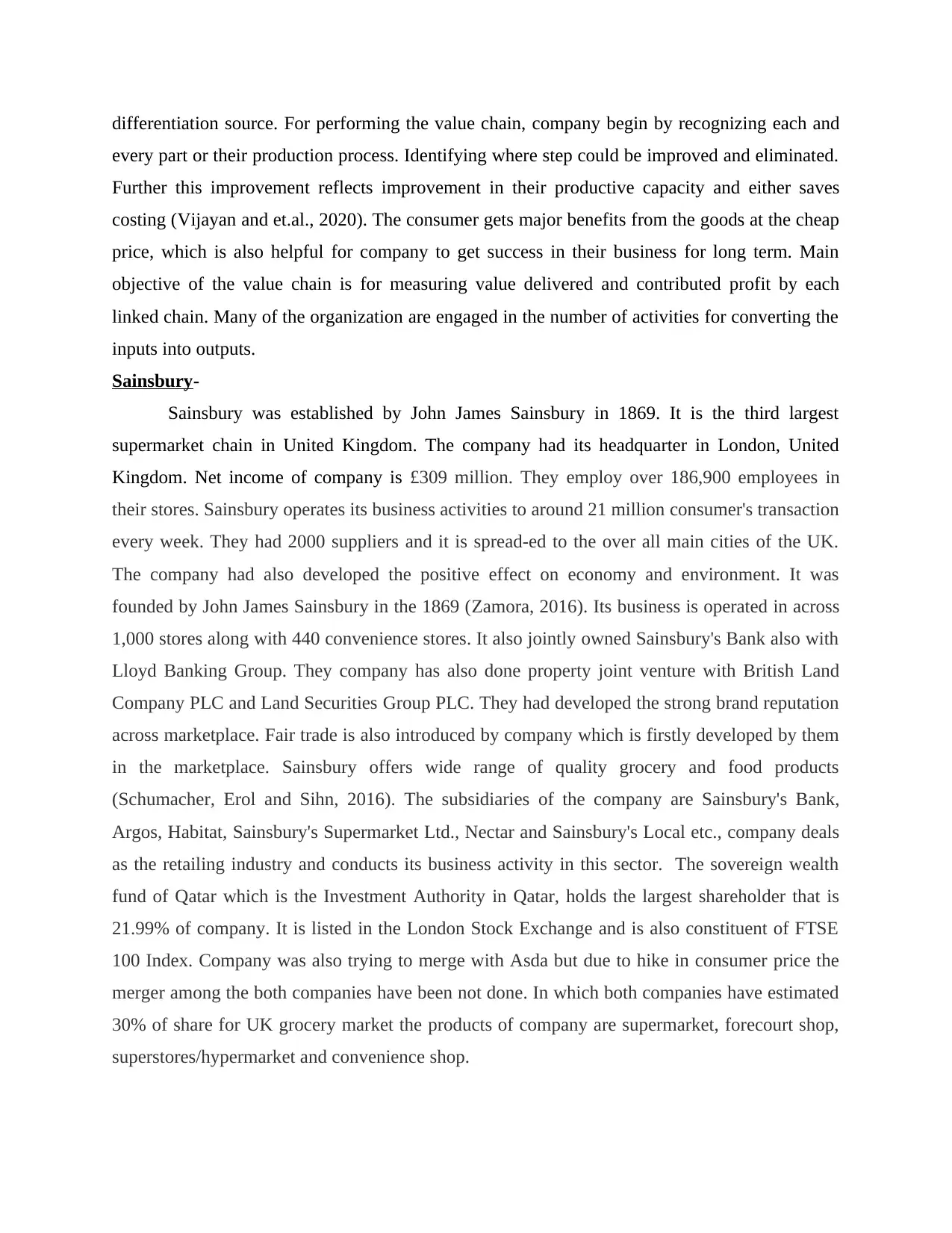
differentiation source. For performing the value chain, company begin by recognizing each and
every part or their production process. Identifying where step could be improved and eliminated.
Further this improvement reflects improvement in their productive capacity and either saves
costing (Vijayan and et.al., 2020). The consumer gets major benefits from the goods at the cheap
price, which is also helpful for company to get success in their business for long term. Main
objective of the value chain is for measuring value delivered and contributed profit by each
linked chain. Many of the organization are engaged in the number of activities for converting the
inputs into outputs.
Sainsbury-
Sainsbury was established by John James Sainsbury in 1869. It is the third largest
supermarket chain in United Kingdom. The company had its headquarter in London, United
Kingdom. Net income of company is £309 million. They employ over 186,900 employees in
their stores. Sainsbury operates its business activities to around 21 million consumer's transaction
every week. They had 2000 suppliers and it is spread-ed to the over all main cities of the UK.
The company had also developed the positive effect on economy and environment. It was
founded by John James Sainsbury in the 1869 (Zamora, 2016). Its business is operated in across
1,000 stores along with 440 convenience stores. It also jointly owned Sainsbury's Bank also with
Lloyd Banking Group. They company has also done property joint venture with British Land
Company PLC and Land Securities Group PLC. They had developed the strong brand reputation
across marketplace. Fair trade is also introduced by company which is firstly developed by them
in the marketplace. Sainsbury offers wide range of quality grocery and food products
(Schumacher, Erol and Sihn, 2016). The subsidiaries of the company are Sainsbury's Bank,
Argos, Habitat, Sainsbury's Supermarket Ltd., Nectar and Sainsbury's Local etc., company deals
as the retailing industry and conducts its business activity in this sector. The sovereign wealth
fund of Qatar which is the Investment Authority in Qatar, holds the largest shareholder that is
21.99% of company. It is listed in the London Stock Exchange and is also constituent of FTSE
100 Index. Company was also trying to merge with Asda but due to hike in consumer price the
merger among the both companies have been not done. In which both companies have estimated
30% of share for UK grocery market the products of company are supermarket, forecourt shop,
superstores/hypermarket and convenience shop.
every part or their production process. Identifying where step could be improved and eliminated.
Further this improvement reflects improvement in their productive capacity and either saves
costing (Vijayan and et.al., 2020). The consumer gets major benefits from the goods at the cheap
price, which is also helpful for company to get success in their business for long term. Main
objective of the value chain is for measuring value delivered and contributed profit by each
linked chain. Many of the organization are engaged in the number of activities for converting the
inputs into outputs.
Sainsbury-
Sainsbury was established by John James Sainsbury in 1869. It is the third largest
supermarket chain in United Kingdom. The company had its headquarter in London, United
Kingdom. Net income of company is £309 million. They employ over 186,900 employees in
their stores. Sainsbury operates its business activities to around 21 million consumer's transaction
every week. They had 2000 suppliers and it is spread-ed to the over all main cities of the UK.
The company had also developed the positive effect on economy and environment. It was
founded by John James Sainsbury in the 1869 (Zamora, 2016). Its business is operated in across
1,000 stores along with 440 convenience stores. It also jointly owned Sainsbury's Bank also with
Lloyd Banking Group. They company has also done property joint venture with British Land
Company PLC and Land Securities Group PLC. They had developed the strong brand reputation
across marketplace. Fair trade is also introduced by company which is firstly developed by them
in the marketplace. Sainsbury offers wide range of quality grocery and food products
(Schumacher, Erol and Sihn, 2016). The subsidiaries of the company are Sainsbury's Bank,
Argos, Habitat, Sainsbury's Supermarket Ltd., Nectar and Sainsbury's Local etc., company deals
as the retailing industry and conducts its business activity in this sector. The sovereign wealth
fund of Qatar which is the Investment Authority in Qatar, holds the largest shareholder that is
21.99% of company. It is listed in the London Stock Exchange and is also constituent of FTSE
100 Index. Company was also trying to merge with Asda but due to hike in consumer price the
merger among the both companies have been not done. In which both companies have estimated
30% of share for UK grocery market the products of company are supermarket, forecourt shop,
superstores/hypermarket and convenience shop.
Paraphrase This Document
Need a fresh take? Get an instant paraphrase of this document with our AI Paraphraser
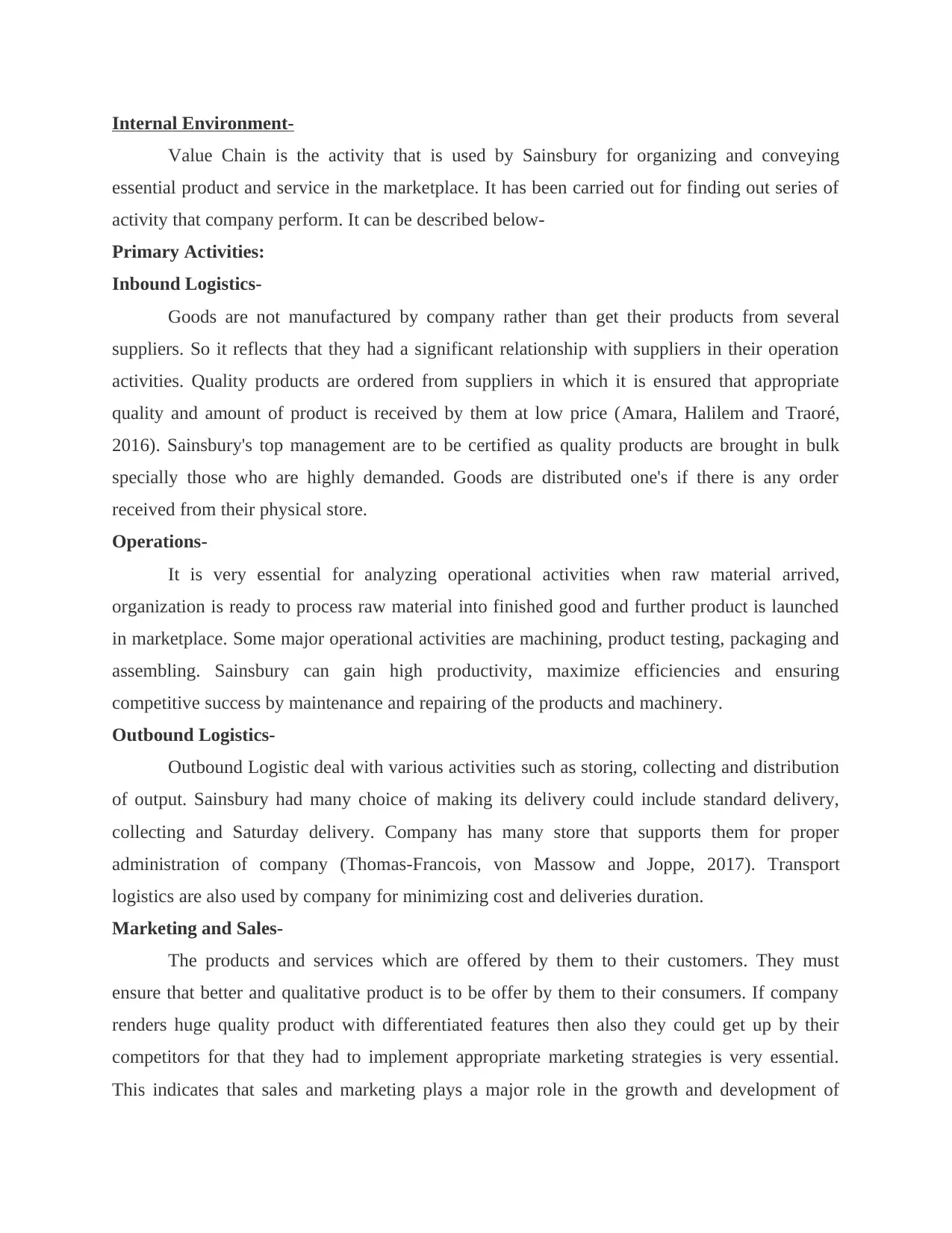
Internal Environment-
Value Chain is the activity that is used by Sainsbury for organizing and conveying
essential product and service in the marketplace. It has been carried out for finding out series of
activity that company perform. It can be described below-
Primary Activities:
Inbound Logistics-
Goods are not manufactured by company rather than get their products from several
suppliers. So it reflects that they had a significant relationship with suppliers in their operation
activities. Quality products are ordered from suppliers in which it is ensured that appropriate
quality and amount of product is received by them at low price (Amara, Halilem and Traoré,
2016). Sainsbury's top management are to be certified as quality products are brought in bulk
specially those who are highly demanded. Goods are distributed one's if there is any order
received from their physical store.
Operations-
It is very essential for analyzing operational activities when raw material arrived,
organization is ready to process raw material into finished good and further product is launched
in marketplace. Some major operational activities are machining, product testing, packaging and
assembling. Sainsbury can gain high productivity, maximize efficiencies and ensuring
competitive success by maintenance and repairing of the products and machinery.
Outbound Logistics-
Outbound Logistic deal with various activities such as storing, collecting and distribution
of output. Sainsbury had many choice of making its delivery could include standard delivery,
collecting and Saturday delivery. Company has many store that supports them for proper
administration of company (Thomas-Francois, von Massow and Joppe, 2017). Transport
logistics are also used by company for minimizing cost and deliveries duration.
Marketing and Sales-
The products and services which are offered by them to their customers. They must
ensure that better and qualitative product is to be offer by them to their consumers. If company
renders huge quality product with differentiated features then also they could get up by their
competitors for that they had to implement appropriate marketing strategies is very essential.
This indicates that sales and marketing plays a major role in the growth and development of
Value Chain is the activity that is used by Sainsbury for organizing and conveying
essential product and service in the marketplace. It has been carried out for finding out series of
activity that company perform. It can be described below-
Primary Activities:
Inbound Logistics-
Goods are not manufactured by company rather than get their products from several
suppliers. So it reflects that they had a significant relationship with suppliers in their operation
activities. Quality products are ordered from suppliers in which it is ensured that appropriate
quality and amount of product is received by them at low price (Amara, Halilem and Traoré,
2016). Sainsbury's top management are to be certified as quality products are brought in bulk
specially those who are highly demanded. Goods are distributed one's if there is any order
received from their physical store.
Operations-
It is very essential for analyzing operational activities when raw material arrived,
organization is ready to process raw material into finished good and further product is launched
in marketplace. Some major operational activities are machining, product testing, packaging and
assembling. Sainsbury can gain high productivity, maximize efficiencies and ensuring
competitive success by maintenance and repairing of the products and machinery.
Outbound Logistics-
Outbound Logistic deal with various activities such as storing, collecting and distribution
of output. Sainsbury had many choice of making its delivery could include standard delivery,
collecting and Saturday delivery. Company has many store that supports them for proper
administration of company (Thomas-Francois, von Massow and Joppe, 2017). Transport
logistics are also used by company for minimizing cost and deliveries duration.
Marketing and Sales-
The products and services which are offered by them to their customers. They must
ensure that better and qualitative product is to be offer by them to their consumers. If company
renders huge quality product with differentiated features then also they could get up by their
competitors for that they had to implement appropriate marketing strategies is very essential.
This indicates that sales and marketing plays a major role in the growth and development of
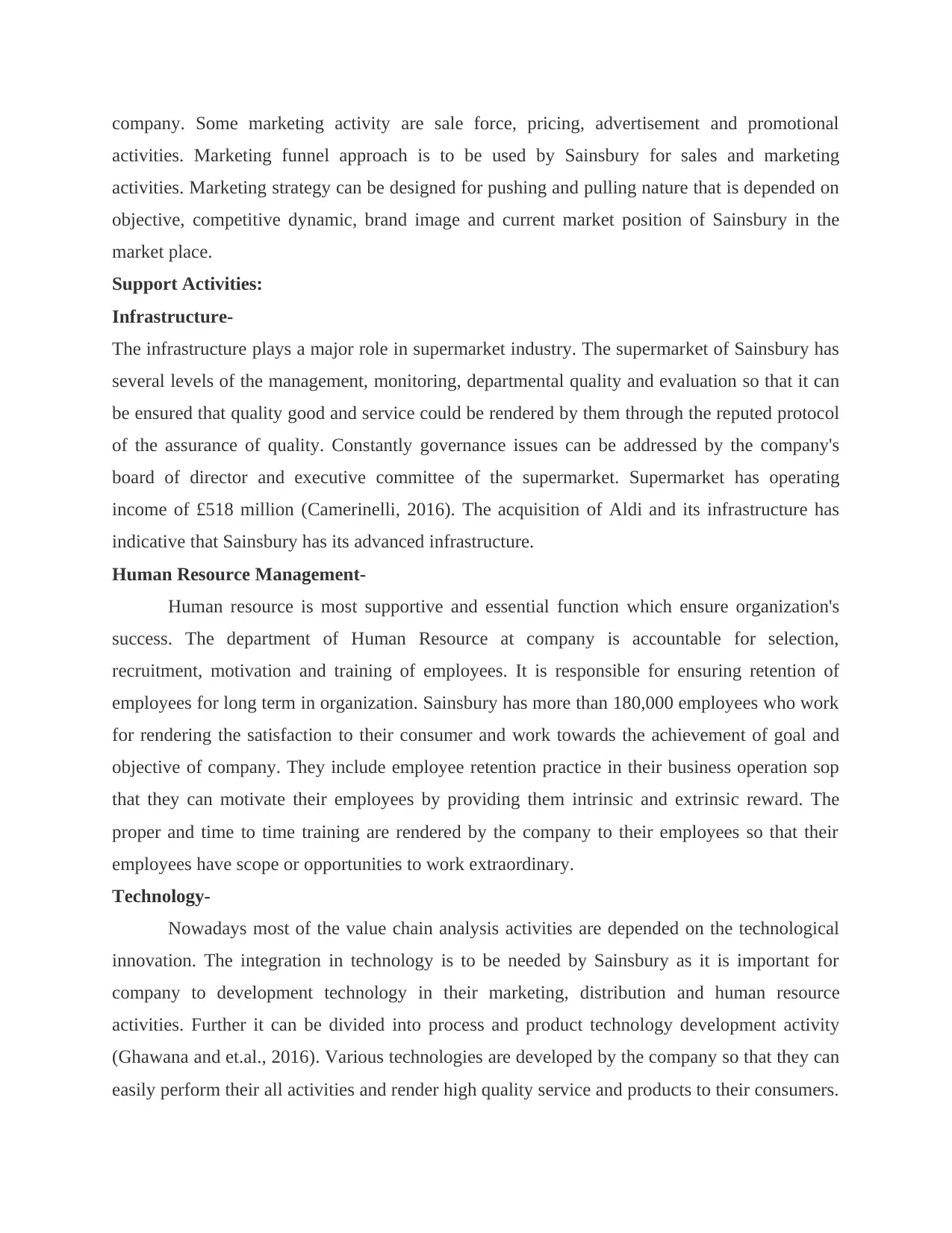
company. Some marketing activity are sale force, pricing, advertisement and promotional
activities. Marketing funnel approach is to be used by Sainsbury for sales and marketing
activities. Marketing strategy can be designed for pushing and pulling nature that is depended on
objective, competitive dynamic, brand image and current market position of Sainsbury in the
market place.
Support Activities:
Infrastructure-
The infrastructure plays a major role in supermarket industry. The supermarket of Sainsbury has
several levels of the management, monitoring, departmental quality and evaluation so that it can
be ensured that quality good and service could be rendered by them through the reputed protocol
of the assurance of quality. Constantly governance issues can be addressed by the company's
board of director and executive committee of the supermarket. Supermarket has operating
income of £518 million (Camerinelli, 2016). The acquisition of Aldi and its infrastructure has
indicative that Sainsbury has its advanced infrastructure.
Human Resource Management-
Human resource is most supportive and essential function which ensure organization's
success. The department of Human Resource at company is accountable for selection,
recruitment, motivation and training of employees. It is responsible for ensuring retention of
employees for long term in organization. Sainsbury has more than 180,000 employees who work
for rendering the satisfaction to their consumer and work towards the achievement of goal and
objective of company. They include employee retention practice in their business operation sop
that they can motivate their employees by providing them intrinsic and extrinsic reward. The
proper and time to time training are rendered by the company to their employees so that their
employees have scope or opportunities to work extraordinary.
Technology-
Nowadays most of the value chain analysis activities are depended on the technological
innovation. The integration in technology is to be needed by Sainsbury as it is important for
company to development technology in their marketing, distribution and human resource
activities. Further it can be divided into process and product technology development activity
(Ghawana and et.al., 2016). Various technologies are developed by the company so that they can
easily perform their all activities and render high quality service and products to their consumers.
activities. Marketing funnel approach is to be used by Sainsbury for sales and marketing
activities. Marketing strategy can be designed for pushing and pulling nature that is depended on
objective, competitive dynamic, brand image and current market position of Sainsbury in the
market place.
Support Activities:
Infrastructure-
The infrastructure plays a major role in supermarket industry. The supermarket of Sainsbury has
several levels of the management, monitoring, departmental quality and evaluation so that it can
be ensured that quality good and service could be rendered by them through the reputed protocol
of the assurance of quality. Constantly governance issues can be addressed by the company's
board of director and executive committee of the supermarket. Supermarket has operating
income of £518 million (Camerinelli, 2016). The acquisition of Aldi and its infrastructure has
indicative that Sainsbury has its advanced infrastructure.
Human Resource Management-
Human resource is most supportive and essential function which ensure organization's
success. The department of Human Resource at company is accountable for selection,
recruitment, motivation and training of employees. It is responsible for ensuring retention of
employees for long term in organization. Sainsbury has more than 180,000 employees who work
for rendering the satisfaction to their consumer and work towards the achievement of goal and
objective of company. They include employee retention practice in their business operation sop
that they can motivate their employees by providing them intrinsic and extrinsic reward. The
proper and time to time training are rendered by the company to their employees so that their
employees have scope or opportunities to work extraordinary.
Technology-
Nowadays most of the value chain analysis activities are depended on the technological
innovation. The integration in technology is to be needed by Sainsbury as it is important for
company to development technology in their marketing, distribution and human resource
activities. Further it can be divided into process and product technology development activity
(Ghawana and et.al., 2016). Various technologies are developed by the company so that they can
easily perform their all activities and render high quality service and products to their consumers.
⊘ This is a preview!⊘
Do you want full access?
Subscribe today to unlock all pages.

Trusted by 1+ million students worldwide
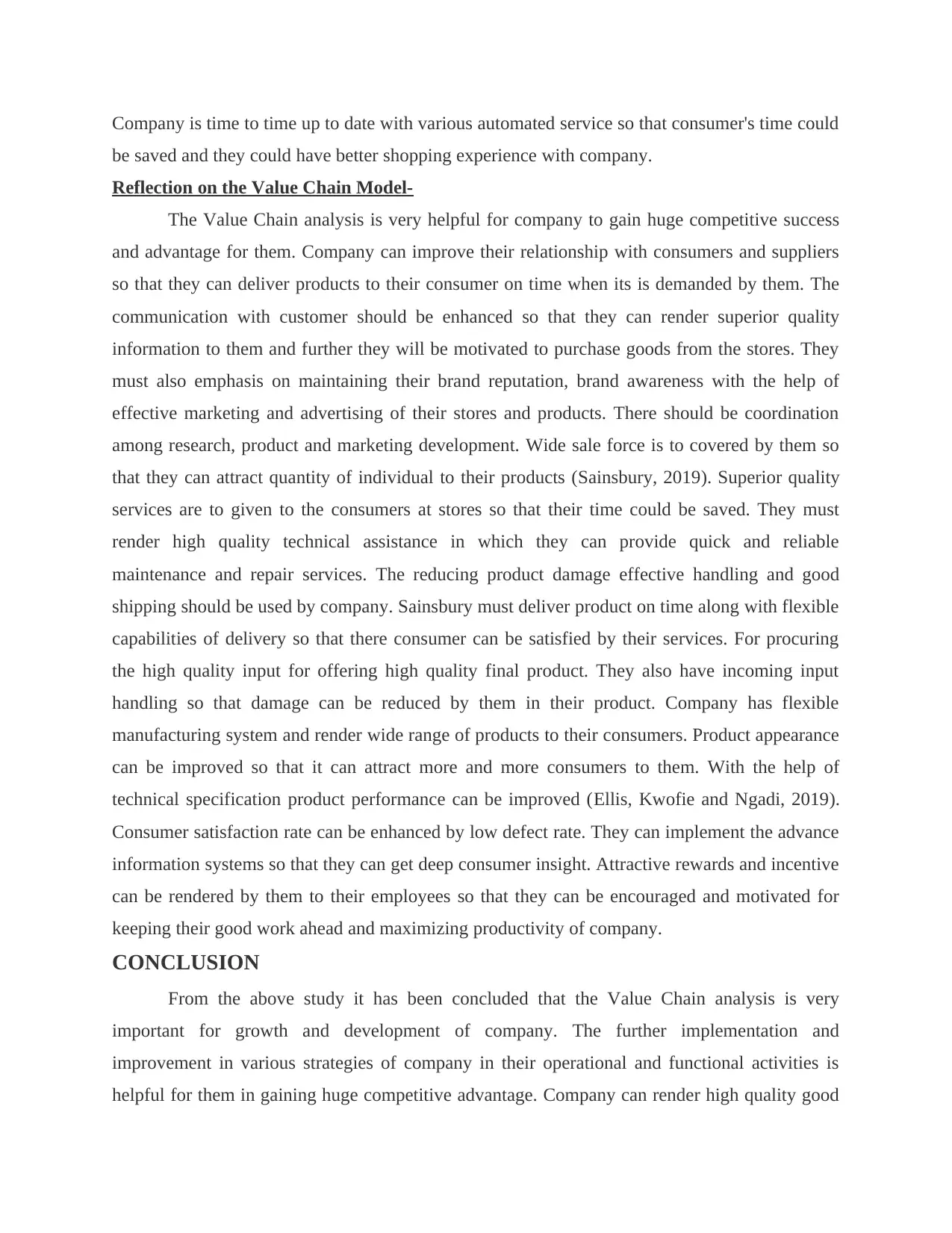
Company is time to time up to date with various automated service so that consumer's time could
be saved and they could have better shopping experience with company.
Reflection on the Value Chain Model-
The Value Chain analysis is very helpful for company to gain huge competitive success
and advantage for them. Company can improve their relationship with consumers and suppliers
so that they can deliver products to their consumer on time when its is demanded by them. The
communication with customer should be enhanced so that they can render superior quality
information to them and further they will be motivated to purchase goods from the stores. They
must also emphasis on maintaining their brand reputation, brand awareness with the help of
effective marketing and advertising of their stores and products. There should be coordination
among research, product and marketing development. Wide sale force is to covered by them so
that they can attract quantity of individual to their products (Sainsbury, 2019). Superior quality
services are to given to the consumers at stores so that their time could be saved. They must
render high quality technical assistance in which they can provide quick and reliable
maintenance and repair services. The reducing product damage effective handling and good
shipping should be used by company. Sainsbury must deliver product on time along with flexible
capabilities of delivery so that there consumer can be satisfied by their services. For procuring
the high quality input for offering high quality final product. They also have incoming input
handling so that damage can be reduced by them in their product. Company has flexible
manufacturing system and render wide range of products to their consumers. Product appearance
can be improved so that it can attract more and more consumers to them. With the help of
technical specification product performance can be improved (Ellis, Kwofie and Ngadi, 2019).
Consumer satisfaction rate can be enhanced by low defect rate. They can implement the advance
information systems so that they can get deep consumer insight. Attractive rewards and incentive
can be rendered by them to their employees so that they can be encouraged and motivated for
keeping their good work ahead and maximizing productivity of company.
CONCLUSION
From the above study it has been concluded that the Value Chain analysis is very
important for growth and development of company. The further implementation and
improvement in various strategies of company in their operational and functional activities is
helpful for them in gaining huge competitive advantage. Company can render high quality good
be saved and they could have better shopping experience with company.
Reflection on the Value Chain Model-
The Value Chain analysis is very helpful for company to gain huge competitive success
and advantage for them. Company can improve their relationship with consumers and suppliers
so that they can deliver products to their consumer on time when its is demanded by them. The
communication with customer should be enhanced so that they can render superior quality
information to them and further they will be motivated to purchase goods from the stores. They
must also emphasis on maintaining their brand reputation, brand awareness with the help of
effective marketing and advertising of their stores and products. There should be coordination
among research, product and marketing development. Wide sale force is to covered by them so
that they can attract quantity of individual to their products (Sainsbury, 2019). Superior quality
services are to given to the consumers at stores so that their time could be saved. They must
render high quality technical assistance in which they can provide quick and reliable
maintenance and repair services. The reducing product damage effective handling and good
shipping should be used by company. Sainsbury must deliver product on time along with flexible
capabilities of delivery so that there consumer can be satisfied by their services. For procuring
the high quality input for offering high quality final product. They also have incoming input
handling so that damage can be reduced by them in their product. Company has flexible
manufacturing system and render wide range of products to their consumers. Product appearance
can be improved so that it can attract more and more consumers to them. With the help of
technical specification product performance can be improved (Ellis, Kwofie and Ngadi, 2019).
Consumer satisfaction rate can be enhanced by low defect rate. They can implement the advance
information systems so that they can get deep consumer insight. Attractive rewards and incentive
can be rendered by them to their employees so that they can be encouraged and motivated for
keeping their good work ahead and maximizing productivity of company.
CONCLUSION
From the above study it has been concluded that the Value Chain analysis is very
important for growth and development of company. The further implementation and
improvement in various strategies of company in their operational and functional activities is
helpful for them in gaining huge competitive advantage. Company can render high quality good
Paraphrase This Document
Need a fresh take? Get an instant paraphrase of this document with our AI Paraphraser
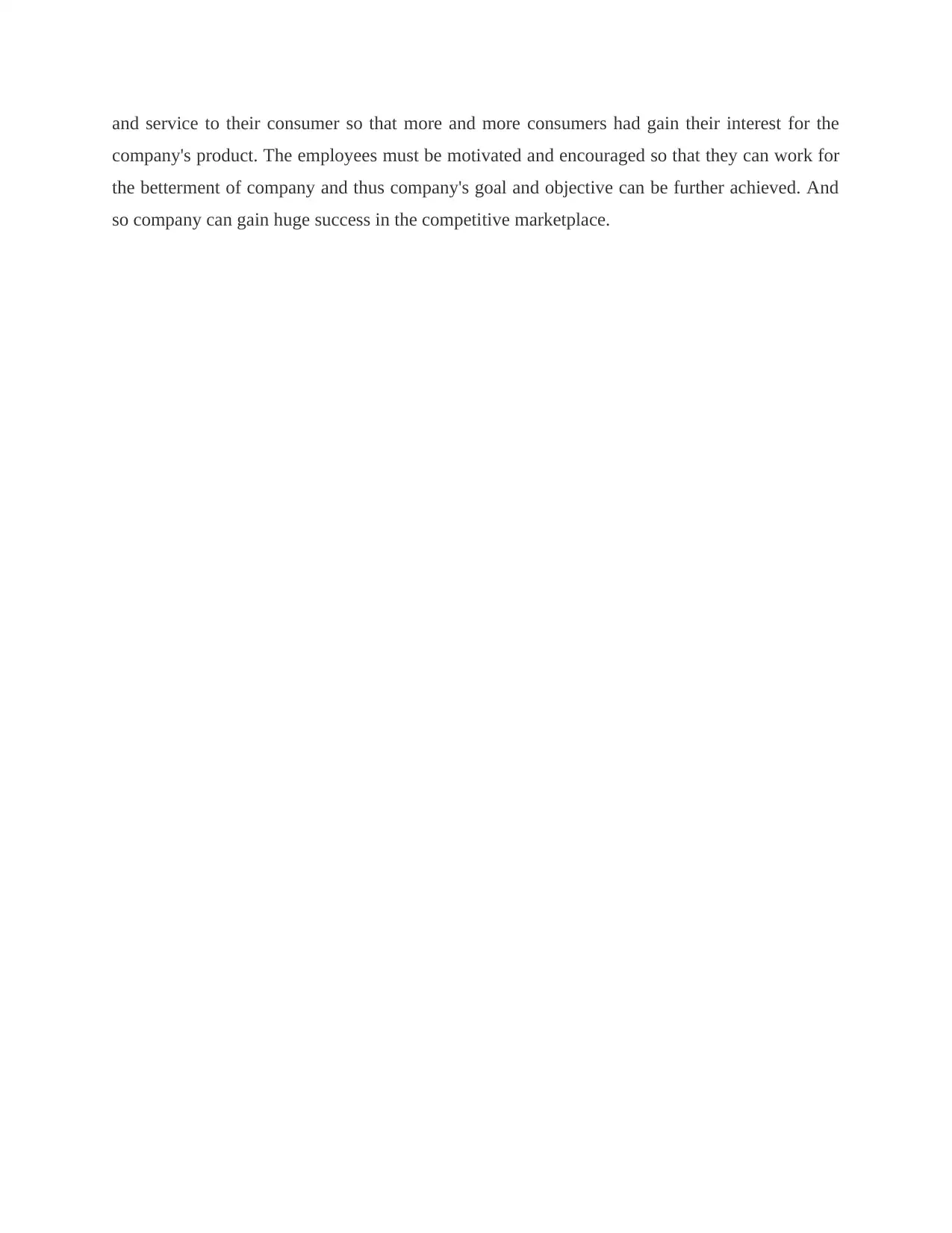
and service to their consumer so that more and more consumers had gain their interest for the
company's product. The employees must be motivated and encouraged so that they can work for
the betterment of company and thus company's goal and objective can be further achieved. And
so company can gain huge success in the competitive marketplace.
company's product. The employees must be motivated and encouraged so that they can work for
the betterment of company and thus company's goal and objective can be further achieved. And
so company can gain huge success in the competitive marketplace.
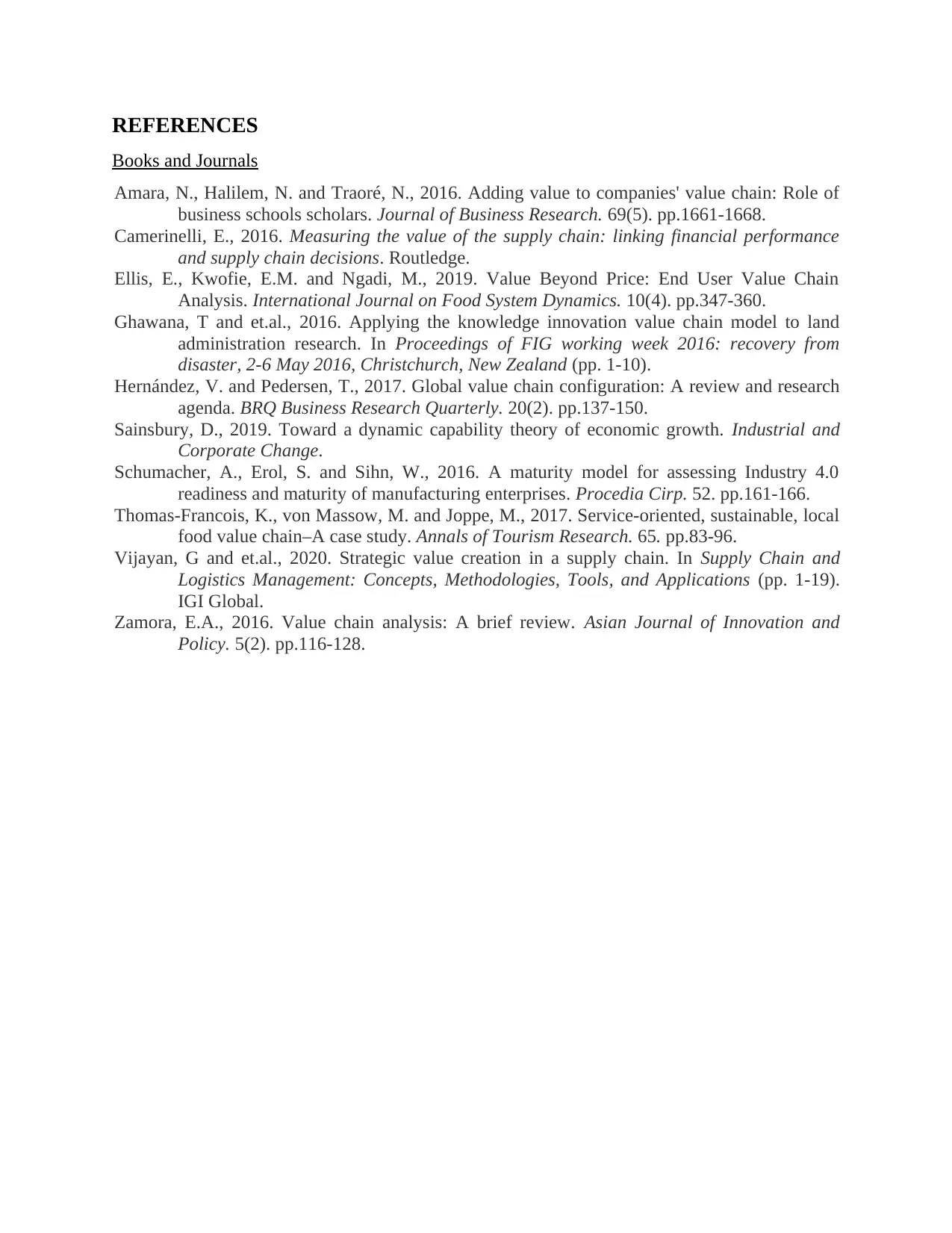
REFERENCES
Books and Journals
Amara, N., Halilem, N. and Traoré, N., 2016. Adding value to companies' value chain: Role of
business schools scholars. Journal of Business Research. 69(5). pp.1661-1668.
Camerinelli, E., 2016. Measuring the value of the supply chain: linking financial performance
and supply chain decisions. Routledge.
Ellis, E., Kwofie, E.M. and Ngadi, M., 2019. Value Beyond Price: End User Value Chain
Analysis. International Journal on Food System Dynamics. 10(4). pp.347-360.
Ghawana, T and et.al., 2016. Applying the knowledge innovation value chain model to land
administration research. In Proceedings of FIG working week 2016: recovery from
disaster, 2-6 May 2016, Christchurch, New Zealand (pp. 1-10).
Hernández, V. and Pedersen, T., 2017. Global value chain configuration: A review and research
agenda. BRQ Business Research Quarterly. 20(2). pp.137-150.
Sainsbury, D., 2019. Toward a dynamic capability theory of economic growth. Industrial and
Corporate Change.
Schumacher, A., Erol, S. and Sihn, W., 2016. A maturity model for assessing Industry 4.0
readiness and maturity of manufacturing enterprises. Procedia Cirp. 52. pp.161-166.
Thomas-Francois, K., von Massow, M. and Joppe, M., 2017. Service-oriented, sustainable, local
food value chain–A case study. Annals of Tourism Research. 65. pp.83-96.
Vijayan, G and et.al., 2020. Strategic value creation in a supply chain. In Supply Chain and
Logistics Management: Concepts, Methodologies, Tools, and Applications (pp. 1-19).
IGI Global.
Zamora, E.A., 2016. Value chain analysis: A brief review. Asian Journal of Innovation and
Policy. 5(2). pp.116-128.
Books and Journals
Amara, N., Halilem, N. and Traoré, N., 2016. Adding value to companies' value chain: Role of
business schools scholars. Journal of Business Research. 69(5). pp.1661-1668.
Camerinelli, E., 2016. Measuring the value of the supply chain: linking financial performance
and supply chain decisions. Routledge.
Ellis, E., Kwofie, E.M. and Ngadi, M., 2019. Value Beyond Price: End User Value Chain
Analysis. International Journal on Food System Dynamics. 10(4). pp.347-360.
Ghawana, T and et.al., 2016. Applying the knowledge innovation value chain model to land
administration research. In Proceedings of FIG working week 2016: recovery from
disaster, 2-6 May 2016, Christchurch, New Zealand (pp. 1-10).
Hernández, V. and Pedersen, T., 2017. Global value chain configuration: A review and research
agenda. BRQ Business Research Quarterly. 20(2). pp.137-150.
Sainsbury, D., 2019. Toward a dynamic capability theory of economic growth. Industrial and
Corporate Change.
Schumacher, A., Erol, S. and Sihn, W., 2016. A maturity model for assessing Industry 4.0
readiness and maturity of manufacturing enterprises. Procedia Cirp. 52. pp.161-166.
Thomas-Francois, K., von Massow, M. and Joppe, M., 2017. Service-oriented, sustainable, local
food value chain–A case study. Annals of Tourism Research. 65. pp.83-96.
Vijayan, G and et.al., 2020. Strategic value creation in a supply chain. In Supply Chain and
Logistics Management: Concepts, Methodologies, Tools, and Applications (pp. 1-19).
IGI Global.
Zamora, E.A., 2016. Value chain analysis: A brief review. Asian Journal of Innovation and
Policy. 5(2). pp.116-128.
⊘ This is a preview!⊘
Do you want full access?
Subscribe today to unlock all pages.

Trusted by 1+ million students worldwide
1 out of 9
Related Documents
Your All-in-One AI-Powered Toolkit for Academic Success.
+13062052269
info@desklib.com
Available 24*7 on WhatsApp / Email
![[object Object]](/_next/static/media/star-bottom.7253800d.svg)
Unlock your academic potential
Copyright © 2020–2025 A2Z Services. All Rights Reserved. Developed and managed by ZUCOL.





